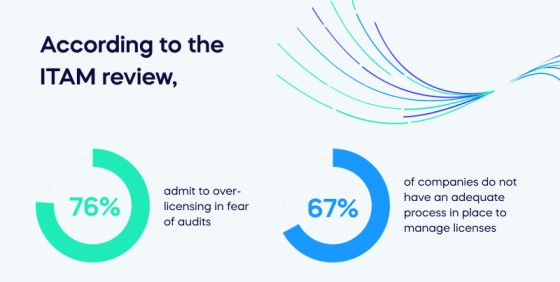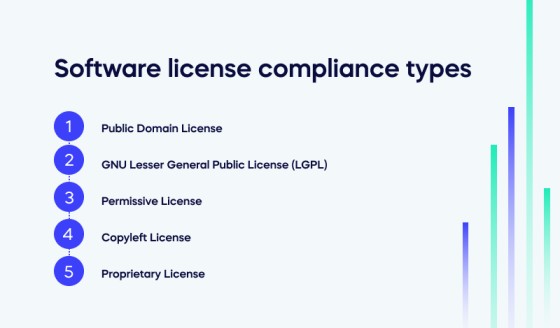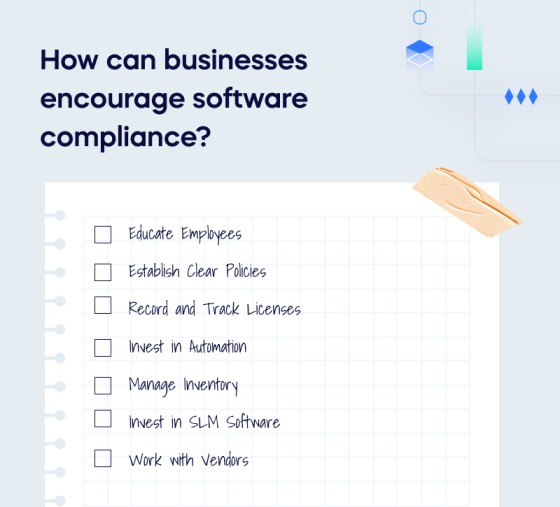In the ever-evolving world of software development and usage, one aspect that remains crucial is software license compliance.
This is the practice of ensuring that licensed software adheres to the terms and conditions outlined by the copyright holder. Both users and software vendors play pivotal roles in maintaining regulatory compliance training.
For users, it is about using the software within the boundaries of the agreed terms to avoid legal repercussions. On the other hand, software vendors need to manage their licenses effectively to safeguard their intellectual property rights and revenue streams.
Agile software development and cloud computing technologies have made creating, launching, a+nd distributing software products easier. Although this has enabled faster time-to-market for innovations, it has also created a minefield of legal complexities when it comes to software license compliance.
According to the ITAM review, 76% admit to over-licensing in fear of audits, and 67% of companies do not have an adequate process in place to manage licenses. This highlights the need for a comprehensive software license compliance strategy covering user rights and vendor obligations.

A great starting point is investing in software license management tools to enable users to effectively keep track of their licenses and usage. For software vendors, such tools help reduce compliance risks while optimizing the utilization and monetization of their software products.
This guide aims to navigate both parties through the complex landscape of software license compliance. It will explore the different types of software licenses, the potential risks of non-compliance, and practical strategies for managing software licenses.
Whether you’re a user trying to understand your rights and responsibilities or a software vendor looking to protect your assets, this guide will equip you with the necessary knowledge and tools for successful software license compliance.
What is software license compliance?
Software license compliance refers to ensuring that software products within an organization adhere strictly to the terms and conditions outlined in their respective licensing agreements.
This includes maintaining the appropriate number of licenses for software use, avoiding unlicensed or pirated software, and fulfilling any other requirements stipulated by the software provider.
Compliance is crucial to avoid legal disputes, financial penalties, and company reputation damage. It also promotes ethical business practices and respect for intellectual property rights.
Why is software license compliance so important?
Software license compliance is pivotal for businesses to ensure legal software use.
It’s not just about staying lawful but also about efficient management of resources and investments. Regular inventory checks of software in use is a practice of a software-compliant business, allowing IT managers to maintain an organized system.
Efficient Software License Management (SLM) provides peace of mind through first-hand, documented proof of license usage, eliminating uncertainties. From a regulatory perspective, license compliance is essential and offers benefits that help businesses remain competitive and efficient in the modern marketplace.
Every End-User License Agreement (EULA) matters, and SLM ensures that your business complies with these agreements. Furthermore, software license management gives organizations a consolidated view of their licenses and deployments across solutions and vendors, enhancing transparency and control.
Below are some of the main advantages of complying with software licensing regulations:
Legal Protection:
- Adhering to software licenses is a legal requirement. Non-compliance can result in severe penalties, including fines and lawsuits.
- Software providers have the right to audit your usage to ensure compliance. If they find discrepancies, you could face legal action.
Financial Implications:
- Unauthorized use of software can lead to unexpected costs. These can include fines imposed during audits and the costs of purchasing necessary licenses after the fact.
- Proper license management can save money by ensuring you only purchase and renew the licenses you need.
Reputation Management:
- Businesses found guilty of license non-compliance can suffer significant reputational damage. This can affect customer trust and future business prospects.
- Compliance shows respect for intellectual property rights, demonstrating ethical business practices.
Software license compliance types

There are several types of software licenses that you need to understand. These include:
- Public Domain License: This is a type of license where the software is not copyrighted and can be used freely by anyone.
- GNU Lesser General Public License (LGPL): The Free Software Foundation (FSF) publishes this free software license. The LGPL allows developers and companies to use and integrate LGPL software into their own (even proprietary) software without being required by the terms of a strong copyleft license to release the source code of their own components.
- Permissive License: This type of license is also known as “BSD style,” “Apache style,” or “MIT style.” It’s permissive because it permits the licensee to use the software without major restrictions.
- Copyleft License: This license allows derivative works but requires them to use the same license as the original work. For example, if you create a project and license it under a copyleft license, anyone who distributes its code — either in part or in full — must also use the copyleft license.
- Proprietary License: Proprietary software is software owned by an individual or a company (usually the one that developed it). There are almost always major restrictions on its use, and its source code is always kept secret.
How can businesses encourage software compliance (checklist)?

IT governance tools that monitor and manage software license compliance can help businesses ensure their systems are up-to-date and compliant.
The following steps can be taken to ensure that a business is software license compliant:
- 1. Educate Employees: Ensure all employees understand the importance of software license compliance and the consequences of non-compliance.
- 2. Establish Clear Policies: Create and enforce policies that clearly state which software can be used and how it can be used.
- 3. Record and Track Licenses: Keep accurate records of all licenses purchased and track their usage.
- 4. Invest in Automation: Invest in automated tools to monitor license usage and alert administrators of discrepancies.
- 5. Manage Inventory: Regularly audit software inventory to ensure it matches license records.
- 6. Invest in SLM Software: Use software license management (SLM) solutions for efficient and accurate compliance monitoring.
- 7. Work with Vendors: Work closely with software vendors to ensure all licenses are up-to-date and compliant.
How to simplify software license compliance
Software license compliance can be complex due to the intricate and frequently updated agreements that come with different software.
However, there are methods to simplify this process and ensure that your organization is using software it is authorized to use:
- Define a Software Licensing Policy: A well-defined policy can guide software usage in your organization. This policy should include rules on the installation and use of software and the consequences for non-compliance.
- Maintain an Inventory of All Software Applications in Use: Keeping a record of all the software applications used in your organization can help track their licenses and identify any unauthorized installations.
- Create and Track Licenses Against Users: Assigning licenses to specific users can help monitor who uses which software and whether they adhere to the license terms.
- Use Software Audit Tools: These tools can generate reports that help manage software license compliance. They provide information about the software used, the number of licenses available, and whether there are any discrepancies.
- Adopt a Simplified Approach to Software Licensing: Some suggest we stop counting to simplify software licensing. This approach encourages focusing on the software’s value rather than the number of licenses.
What’s next for software license compliance?
As we peer into the future, several trends will likely revolutionize how we manage software licenses, making the process more efficient, transparent, and secure.
One significant trend is the shift toward automation. Automated license compliance solutions are gaining traction, reducing the manual efforts required for tracking and managing licenses. These solutions leverage AI and machine learning (ML) algorithms to monitor software usage across various platforms, ensuring optimal utilization and preventing overuse or underuse of licenses. Predictive analytics embedded in these tools will anticipate future software needs, triggering automatic procurement or decommissioning of licenses based on usage patterns.
Fintech technology, such as blockchain, is also set to play a pivotal role in software license compliance. Blockchain’s immutable, decentralized nature can provide a secure, transparent platform for recording and verifying software licenses. Each license can be represented as a digital token on the blockchain, making it traceable and tamper-proof. This technology could eliminate the risk of license fraud or misuse, providing a reliable, auditable record of software ownership and usage.
The rise of cloud computing is another game-changer. With the shift from on-premise software to cloud-based services, software licensing is moving towards a subscription model. This model provides flexibility, allowing businesses to scale up or down based on their needs. However, it also introduces new compliance challenges, as companies must manage multiple subscriptions across different native cloud platforms. Future compliance solutions must provide robust cloud license management capabilities, enabling businesses to track and optimize cloud software usage.
Lastly, regulatory changes are likely to influence future compliance strategies. As governments worldwide implement stricter data protection and privacy laws, businesses must ensure that their software usage complies with these regulations. Compliance solutions must incorporate regulatory compliance features, helping companies to navigate this complex legal landscape.
The future of software license compliance will be shaped by a convergence of technologies such as AI, blockchain, cloud computing, and IoT, along with evolving business practices and regulatory changes. These trends promise a more efficient, secure, and transparent approach to managing software licenses, transforming this critical aspect of IT management.


